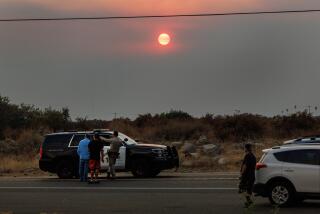Southland Has El Nino to Thank for Clean Air
El Nino, that dreaded weather meddler from the South Pacific, may be brewing epic winter storms, but for now it’s cleansing the air over Southern California, prompting air quality officials to predict the most smog-free year in the four decades in which measurements have been taken.
If the pattern holds for the rest of the month, the Los Angeles area may lose its perennial claim to the smoggiest skies in the nation.
The smog season won’t be over until October, but so far in 1997 the region has experienced only a single Stage 1 alert, which signals the most unhealthful air--contrasted with seven alerts by this time last year. Moreover, there have been only 25 days this year when the South Coast Air Quality Management District has issued health advisories, warning people to limit time spent outdoors, compared to 48 by last September.
“Chances are that 1997 will be the cleanest year on record,” said the AQMD’s senior meteorologist, Joe Cassmassi. If that is the case, it will be the sixth straight year air quality has improved in Southern California.
But although past improvements have been credited to technological advancements, such as the cleaner-burning fuel motorists began using last year, the latest change in air quality appears to be largely the result of nature’s influence, Cassmassi said Thursday.
El Nino, the weather phenomenon that periodically affects climate and water temperatures around the world, has spawned a pattern of low pressure off the California coast, according to the AQMD. And that has ushered in tropical moisture, cloudiness and cooler temperatures for much of the year, all of which have reduced smog, which thrives in sunlight and stagnant air.
“The calling card of El Nino is humidity and instability of the kind that has led to the thunderstorms over the mountains and is likely to bring more storms later in the year,” Cassmassi said.
El Nino shows up every few years when trade winds shift in the Pacific, displacing the normal cold currents, warming the water and often triggering storms.
This year’s clean air is the latest in a series of portents--including high surf, unusually warm coastal water temperatures and the northward migration of fish that normally favor the tropics--that have led meteorologists to warn that the 1997 El Nino may turn out to be the most severe since 1982.
In that year, the most destructive El Nino of the century took place, killing hundreds of people in South America, ruining crops and fishing along much of the Pacific Coast and kicking up waves big enough to destroy homes from Malibu to Santa Barbara.
Ironically, the AQMD chose a day for its clean air announcement when the impact of El Nino seemed worlds away. Smog crept up to unhealthful levels Thursday in the San Gabriel Valley.
“Periodically, high pressure can build back in, and that’s what we’re seeing,” Cassmassi said. “By next week, I think we will be going back to a more typical format for this year--more clouds, moisture and cleaner air.”
Though the air in some places Thursday exceeded federal ozone standards, it did not trigger any health advisories.
So far this year, AQMD officials pointed out, Houston has recorded a peak ozone level higher than anywhere in Southern California. But the AQMD also noted that the South Coast region has rung up 60 days, compared to Houston’s 35, when ozone levels exceeded the federal standard for healthy air. Last year at this time, Southern California had experienced 76 days in which ozone levels surpassed the federal standard.
Ozone, which can cause lung damage, is not the only hazardous component of smog, but is the most easily measured. Ozone typically is formed when nitrogen oxides interact in sunlight with other waste products of combustion and airborne chemicals. Several miles high, ozone in the atmosphere has a much different effect, shielding Earth from the sun’s ultraviolet rays.
More to Read
Sign up for Essential California
The most important California stories and recommendations in your inbox every morning.
You may occasionally receive promotional content from the Los Angeles Times.










